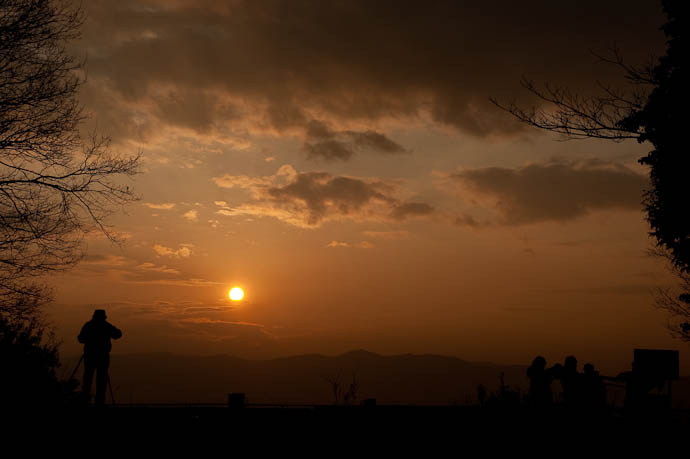NOTE: Images with an  icon next to them have been artificially shrunk to better fit your screen; click the icon to restore them, in place, to their regular size.
icon next to them have been artificially shrunk to better fit your screen; click the icon to restore them, in place, to their regular size.

Nikon D700 + Nikkor 24-70mm f/2.8 @ 70 mm — 1/640 sec, f/11, ISO 200 — map & image data — nearby photos
Sunset from the Shogunzuka Overlook
Kyoto, Japan
I'd planned to write up a bit about the fun of spot metering, but have run out of time for today.... it seems that I'm extra busy lately. I did take a moment yesterday to run up to Shogunzuka in hopes of catching a nice sunset. It was pretty dull, but through the magic (or mistake, depending on your point of view) of spot metering, some of the photos of it came out okay. [UPDATE: here's the post on spot metering]
I tend to like this kind of silhouette shot at this location, as the nearby photos link shows, including: this, this, this, and this.
Leave a comment...
Hi, my name is Alexandra and I’m a student from Singapore. I have school project about Japan and I would like to use your wonderful photos for my project. Of course, credits go to you for the photos.
For me this is just about perfect! I’ve no idea how closely it represents what you saw, but it is a beautiful image and I think it may be heading for my desktop! What were you spot-metering on – the clouds near the centre?
That one wasn’t spot, it was center-weighted average. In this case, it’s much prettier in the photo than reality was. —Jeffrey
Hi Jeffrey,
Thank you for the post about spot metering. I often read the camera reviews on DPreviews(dot)com. They are really in depth and lots of the information they contain are kind of heady and hard to fathom. Spot-metering USED to be one of them, thanks to your post I feel like I understand that capability now.
I also read your post about not wanting to use HDR. The fascinating thing about the photos you present is that they look like maybe a Morrocan desert right before the sun goes down in the heat of the summer 6:30-7:30pm… and then you show the photo of the other photographer and it looks like 2 or 3 in the afternoon, maybe, (and 14 seconds later at that).
Based on your exposure settings you get wildly different results. Some might argue that through your camera you are manipulating reality as much as the HDR / photoshop tweakers.
I’d disagree with that assessment for one reason:
A good portion of what makes your photographs and blog in general so interesting is your honesty. You provide a good bit of detail about how the photographs are made… and everybody loves the story behind the story. You reveal that you use bracketing and post production.
What makes HDR so cheezy or gimmicky is when people make the lame attempt to pass it off as unretouched straight from the camera. They are almost as bad as the before/after photos you see in the fitness magazine advertisements. The gag reflex goes way down when the artist admits, “I blended this image together from 9 exposures. ”
Since the tech is limited, and at the same time so unlimited (in terms of camera/software features) we are all in a sense image makers vs. photographers just maybe to lesser or greater degrees.
Here is an interesting thought: Some silver camera purists deride digital cameras. some darkroom specialists deride photo-software. It took years for the art world to view photography as an artform and also said that photography could NOT capture the subtlety that painting could… and I bet somewhere way back someone said oil paint has nothing on eggwhites/pigment frescos etc. and on and on.
When that new technology is invented (that expands the range of cameras and viewing mediums) there will be people saying, “X-new technology is soulless, it doesn’t have the flavor and robustness of good old fashioned Photoshop, Lightroom etc. People will say, “This new X technology, makes images that are the equivalent of breast implants. They’re too perfect. As for me, I’m sticking with my good ol’ fashioned Nikon D9XXi and Photoshop CS9-H (The H standing for Hologram, of course – LOL)
Now won’t that be funny!?
Excellent tutorial on spot metering.